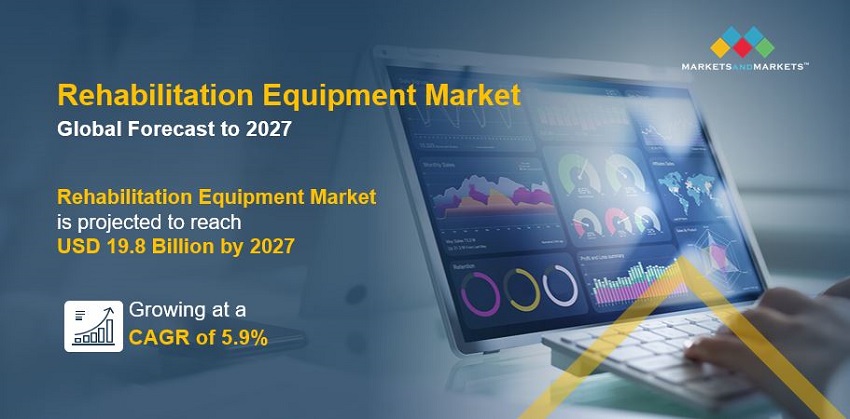The Global Rehabilitation Equipment Market is projected to reach USD 19.8 billion by 2027 from USD 14.9 billion in 2022, at a CAGR of 5.9% during the forecast period. The growth of this market is primarily driven by the increasing prevalence of chronic diseases such as arthritis and cancer, requiring rehabilitation therapies, high risk of injuries to caregivers during the manual handling of patients, rising geriatric and obese populations, and increasing demand for rehabilitation therapies owing to increasing access to healthcare. However, reimbursement issues and persistent difficulties in handling bariatric patients are some of the key challenges in the market.
Download PDF Brochure:
https://www.marketsandmarkets.com/pdfdownloadNew.asp?id=194775519
Mobility Equipment Industry Dynamics
Drivers:
The manual handling of disabled patients may result in severe musculoskeletal injuries to caregivers. The risk of back injuries increases during lateral transfer, as caregivers must reach over the stretcher to the bed and physically pull the patient across onto a stretcher. This movement forces the body of caregivers into an awkward posture, which can cause musculoskeletal discomfort.
Restraints: Lack of awareness and access to rehabilitation services in emerging markets
A general lack of awareness on the effective use of rehabilitation equipment is expected to restrain the growth of this market. For example, in the case of a stroke, the lack of proper assistance and rehabilitation at the correct juncture can have significant ill-effects on the functioning of the body. This lack of awareness can also lead to patients neglecting the symptoms of critical conditions entirely, which affects the adoption of rehabilitation. This is a key problem in countries, such as Malaysia and Taiwan, where the effects of this factor are compounded by a lack of sufficient infrastructure and manpower.
Opportunities: Rising demand for home healthcare services
Globally, an increasing number of government regulations are being implemented to reduce the duration and cost involved in healthcare treatments. The provision of services at a patient’s home is typically more cost-effective than in institutions, particularly if the available informal care is used effectively. Moreover, with the evolution of new technologies, such as remote patient monitoring, the home care segment is expected to witness significant growth in the coming years. The growing demand for home care will, in turn, increase the demand for equipment required for treating patients in home care settings, including patient transfer devices, mobility devices, and medical beds, in the coming years
Challenges: Reimbursement issues
Reimbursement is a key area that directly affects the adoption of rehabilitation equipment. A number of products in this market are priced at a premium and may not be affordable for patients; in such a case, they would have to depend on reimbursement to access the equipment. Various organizations, such as Medicare and Medicaid in the US, provide only limited coverage for rehabilitation equipment such as hospital beds, patient lifts, commode chairs, crutches, walkers, and manual and electric wheelchairs and scooters. Moreover, this coverage is only applicable for the purchase or rentals from Medicare suppliers, as the supplier is prohibited by Medicare rules to charge more than the Medicare-approved amount for equipment.
“The rehabilitation equipment industry is projected to grow at a CAGR of 5.9% between 2022 and 2027.”
The global market is projected to reach USD 19.8 billion by 2027 from USD 14.9 billion in 2022, at a CAGR of 5.9% during the forecast period. The growth of this market is primarily driven by significant risk of injuries to caregivers while manually handling the patients, increasing growth in geriatric and obese population that often requires rehabilitation therapies, and an increasing demand for rehabilitation care with an increasing access to healthcare. However, a lack of training provided to caregivers for the efficient operation of rehabilitation equipment is a major factor restraining market growth.
“Therapy equipment was the largest and fastest-growing segment by product”
Based on product, the rehabilitation equipment market is segmented into therapy equipment, daily living aids, mobility equipment, exercise equipment, and body support devices. In 2021, the therapy equipment segment accounted for the largest share of the global market. Increasing growth in the patients opting for physiotherapy and rehabilitation therapies are driving the demand for therapy equipment globally.
“physical rehabilitation & training segment is the largest application segment”
Based on application, the rehabilitation equipment market is segmented into strength, endurance, and pain reduction; physical rehabilitation & training; and occupational rehabilitation & training. In 2021, the physical rehabilitation & training segment accounted for the largest share of the global market. Physical rehabilitation and training help with osteoarthritis, joint replacement, sports injury, knee pain, back pain, carpal tunnel syndrome, Alzheimer's disease, multiple sclerosis, and cerebral palsy. Increasing incidence of above mentioned injuries and diseases are resulting into a significant growth in the segment.
“Hospitals and clinics segment is the largest end user segment”
Based on end users, the rehabilitation equipment market is segmented into hospitals & clinics, rehabilitation centers, physiotherapy centers, home care settings, and other end users. In 2021, the hospitals and clinics segment accounted for the largest share of the global market. Medical beds, slings, hoists, and bathroom and toilet assist devices are commonly used rehabilitation equipment across hospitals. The demand for these equipment are increasing owing to increasing prevalence of diseases/conditions requiring hospital-based treatment.
Request 10% Customization:
https://www.marketsandmarkets.com/requestCustomizationNew.asp?id=194775519
“Europe to witness the highest growth rate during the forecast period.”
Europe accounted for the largest share of the global rehabilitation equipment market. The large share of this regional segment is attributed to a significant contribution from an economically stable and technologically advanced countries such as Germany, UK, and France. Increasing geriatric population and rising prevalence of musculoskeletal disorders across these countries are driving the market growth in Europe. The Asia Pacific market is projected to register the highest CAGR during the forecast period. Market growth in the Asia Pacific is attributed to the rising healthcare expenditure and growing number of healthcare facilities in Asian countries.
Recent Developments
- In May 2022, Etac AB (Sweden) announced the launch of R82 Crocodile (size 0), the smallest walking aid by the company.
- In March 2022, Medline Industries, LP (US) announced a USD 725 million prime vendor partnership with Mount Sinai Health System (US), to enhance their supply chain strategy and improve patient outcomes.
- In March 2022, Prism Medical (UK) announced a partnership with IoT Solution Group (UK), to enable Prism Medical to advance its existing product portfolio and expand into the smart healthcare market.
- In February 2022, Invacare announced the launch of its next-generation e-fix eco Power Assist Device to upgrade its manual wheelchairs.
Key Market Players:
Baxter International (US), Invacare Corporation (US), Medline Industries, LP (US), Arjo (Sweden), Colfax Corp. (US), Dynatronics Corp. (US), Handicare Group AB (Sweden), Drive DeVilbiss International (Germany), Etac AB (Sweden), GF Health Products Inc. (US), Joerns Healthcare LLC (US), Prism Medical UK Ltd. (UK), Guldmann (Denmark)
Objectives of the Study
- To define, describe, and forecast the rehabilitation equipment market on the basis of product, application, end user, and region
- To provide detailed information about the factors influencing the market growth (such as drivers, restraints, challenges, and opportunities)
- To strategically analyze micromarkets1 with respect to the individual growth trends, prospects, and contributions to the overall rehabilitation equipment market
- To analyze market opportunities for stakeholders and provide details of the competitive landscape for key players
- To forecast the size of the market segments with respect to four regions, namely, North America, Europe, Asia Pacific, and rest of the world.
- To profile the key players and comprehensively analyze their core competencies2 in terms of key developments, product portfolios, and recent financials
- To track and analyze competitive developments such as acquisitions, product launches, partnerships, and expansions in the rehabilitation equipment market



